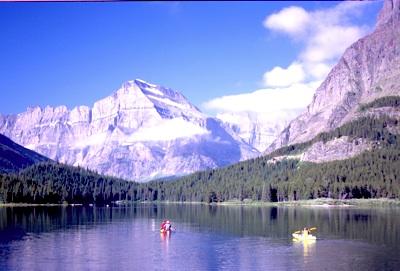Concerns over the introduction of non-native pests into the waters of Glacier National Park have led to changes in boating and fishing rules at the park.
Among the changes: If you want to launch a motorized boat into any of the park's lakes (where allowed), you'll need a permit, which can be obtained at any backcountry permit center. Additionally, all boats must be certified to be free of Aquatic Invasive Species to qualify for a launch permit. That certification might require a visual inspection by park officials. Details of the permit process are available at
http://www.nps.gov/glac/planyourvisit/boating.htm.
Another change in regulations pertains to frontcountry camping, according to park officials.
A person or party may not camp in the same campground more than 14 consecutive days during the time period that camping fees are charged. When no fees are charged a person or party may not camp in the same campground more than 14 days a month. Previously a person or party could not occupy the same campsite for more than seven (7) consecutive days, and when no fees were charged, could not camp in same campground for more than seven (7) consecutive nights or more than 14 nights in a season.
“This change in frontcountry camping limits is based on some campers taking advantage of a loophole that allowed a party to stay in the same campground for the entire summer," said Glacier Superintendent Chas Cartwright. "This effectively locked out other campers, and was not in keeping with Glacier National Park’s mission to conserve the park and provide for its enjoyment by all.”
This change also makes Glacier’s camping limits consistent with other parks and forests in Montana and Wyoming.
As for fishing, the park has adopted catch-and-release regulations for cutthroat trout in all park waters within the North and Middle Fork of the Flathead River drainages, with very limited exceptions. Brook trout limits have been increased to 20 fish park-wide. The changes are intended to conserve native species while also trying to tamp down non-native species.
Anglers are reminded that it is their responsibility to know how to correctly identify fish species prior to harvesting a fish and that the use of all lead fishing gear (except downrigger weights) is prohibited in the park. The only live bait permitted in the park under the new regulations are earthworms, mealworms, and maggots, crickets, grasshoppers, and other terrestrial bait. Fish, fish parts, and non-preserved fish eggs may not be used as bait.
These boating, fishing, and camping rule changes were contained in the 2010 Glacier National Park Compendium. The compendium is the park’s collection of rules and regulations. Each year the superintendent, under his discretionary authority, establishes regulations that designate certain closures, permit requirements and other restrictions in the park.
There are a number of other minor changes that further define or fine-tune existing regulations included in the compendium, which is available at http://www.nps.gov/glac/parkmgmt/lawsandpolicies.htm.




Add comment